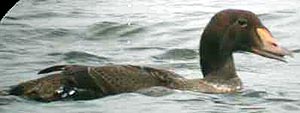
King Eider
Point Reyes National Seashore (Fish Docks), Marin County, California
23 February 2001
Joseph Morlan
 Photos © 20 January 2001 by Joel
Weintraub.
Photos © 20 January 2001 by Joel
Weintraub. The following is based on notes made while watching the bird:
A large sea duck, noticeably larger than adjacent Surf Scoters. Overall brown in color, with a rather bright orange bill.
The bill was relatively short and stubby, somewhat goose-like in shape and had a pale tip including the nail. The culmen was slightly recurved. The brown feathering on the head extended laterally along the side of the bill and down the middle of the culmen. The lateral maxillary feather projections appeared slightly shorter than the central culmen projection and extended down the bill not reaching the nostril. The bill was typically held pointed slightly downward.
The head was mostly dark brown, but with a reddish cast. A faint crease in the feathering extended behind the eye and down the side of the neck. The cheek area usually appeared somewhat darker than the rest of the head, depending on the angle. The dark eye was surrounded by a faint greenish or olive eyering. The head profile showed a high rounded crown and a puffy base to the head above the narrower neck.
The chest was pale with faint brown mottling outlined in black. The sides and scapulars were black, but the back and wing coverts were lighter brown, edged neatly with gray producing a scaly appearance. The net effect was of a large brown bird, with black racing stripes and black sides. The visible secondaries showed pale bases, and the innermost secondaries were much longer than the outer secondaries, forming a projection behind the folded wing. An even longer projection was produced by the extensions of the lower black scapulars, which had pointed tips crossing over the middle of the uppertail coverts.
The upper and lower tail coverts were light brown, but barred heavily with dusky. The tail was relatively short and dark. When the bird raised itself out of the water, the belly appeared to be very dark with some light mottling.
The feet were visible beneath the water as the bird dived and appeared to be yellowish in color.
I judged this bird to be an immature male. The contrasting black scapulars appeared to have been newly grown in the month since Joel Weintraub took the photos accompanying this description. Additional photos of this bird by Joel Weintraub have been posted here. Helpful tips on seeing the bird are here. Mark Eaton discusses eider identification in more detail here.
[Home]